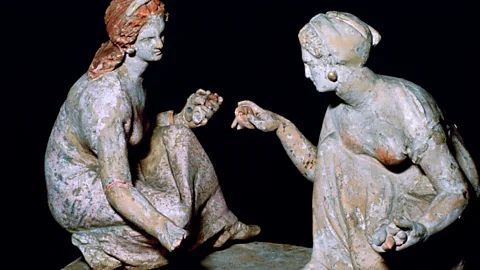The mystery ancient toys puzzling archaeologists
 Getty Images
Getty ImagesThe world's oldest toys date back thousands of years – but determining whether ancient children played with them, and how, remains a mystery archaeologists are piecing together.
Over the two decades that archaeologist Gus Van Beek excavated Tell Jemmeh, an Assyrian settlement inhabited from around 3,800 to 2,200 years ago, he recovered so many objects, it took the Smithsonian 40 years to catalogue them all. There were coins. Scarabs. Amulets. And an amount of pottery so vast, some of it later would have to be discarded.
But for Van Beek, the site – in what is now modern-day south-west Israel – yielded a discovery that was "among the more enigmatic objects recovered": 17 small, rounded discs – some made of chalk, some of stone, but most upcycled from potsherds – with two deliberate holes in the centre.
Van Beek wasn't the first archaeologist to discover objects like these. Nor was he the last. They've been found at sites across Japan, Egypt, India, and the Americas, among others. Three were found in New York City at the site of a British army camp during the American War of Independence, one fashioned from a coin. Others found elsewhere date back 4,000 years.
Some archaeologists believed they were buttons. For others, they were loom weights, perforated pottery, or simply "miscellaneous objects". But they reminded Van Beek of something else. "I ed playing in my early years with a similar object," he remarked. Thread string through the holes, then stretch and relax the string, and the discs spin. He called the objects what they were known as when he was a child – "buzzes" – and went so far as to experiment with creating one himself.
While a handful of earlier scholars also suspected these were toys, others were sceptical. Relying on one's own childhood memories, and projecting our own, modern experience onto a distant society, seemed unacademic at best.
The mystery of the ancient buzzes is just one of many archaeological puzzles related to children's play, and one that highlights many of the pitfalls of studying it. We know that children played. We know they often played with objects. But other questions, such as which objects, and in what way, have remained stubbornly difficult to pinpoint. So difficult, in fact, that they've inspired archaeology's version of a "dad joke": an archaeologist finds a small object. "Hey, what's this">window._taboola = window._taboola || []; _taboola.push({ mode: 'alternating-thumbnails-a', container: 'taboola-below-article', placement: 'Below Article', target_type: 'mix' });
